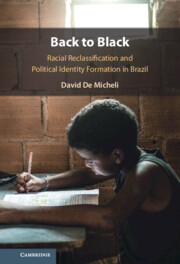Book contents
- Back to Black
- Back to Black
- Copyright page
- Epigraph
- Contents
- Figures
- Tables
- Acknowledgments
- 1 Introduction
- 2 The Puzzle of Racial Reclassification
- 3 Theory
- 4 Education as a Mechanism of Exposure
- 5 Education and Reclassification
- 6 Affirmative Action and Reclassification
- 7 Implications for National Politics
- 8 Conclusion
- References
- Index
6 - Affirmative Action and Reclassification
Published online by Cambridge University Press: 14 November 2024
- Back to Black
- Back to Black
- Copyright page
- Epigraph
- Contents
- Figures
- Tables
- Acknowledgments
- 1 Introduction
- 2 The Puzzle of Racial Reclassification
- 3 Theory
- 4 Education as a Mechanism of Exposure
- 5 Education and Reclassification
- 6 Affirmative Action and Reclassification
- 7 Implications for National Politics
- 8 Conclusion
- References
- Index
Summary
Chapter 6 turns to affirmative action. I begin with a discussion of two affirmative action-based hypotheses, one instrumental and the other symbolic. Both hypotheses point to these race-targeted policies as explanations for the reclassification reversal. I then test these hypotheses in several ways. First, I analyze priming and list experiments to probe for evidence of strategic manipulation in response to affirmative action. Second, I return to the municipal panel dataset and conduct a difference-in-difference analysis of state-level affirmative action on identification. And finally, I analyze an original panel dataset of university students, constructed from embargoed surveys held by the Ministry of Education in Brazil, to compute difference-in-difference estimates of the effects of affirmative action usage on the identifications of university applicants. Overall, evidence is mixed and inconsistent. Evidence suggests that, as part of the broader array of policies that expanded education, affirmative action does boost the effects of education. But the reclassification reversal cannot be reduced to, nor solely explained by, affirmative action policies.
Keywords
- Type
- Chapter
- Information
- Back to BlackRacial Reclassification and Political Identity Formation in Brazil, pp. 171 - 208Publisher: Cambridge University PressPrint publication year: 2024

